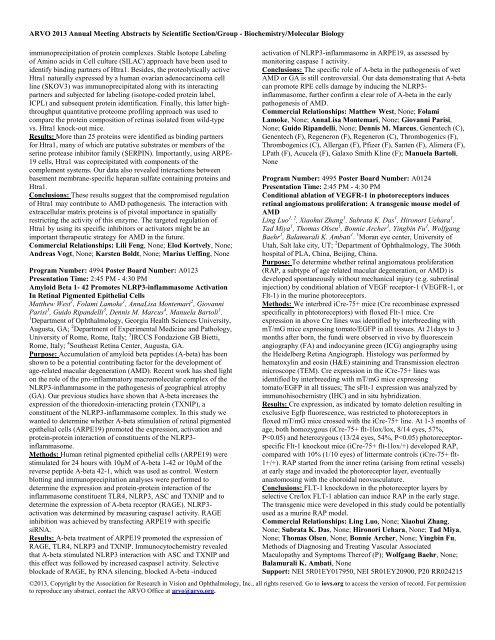Biochemistry/Molecular Biology - ARVO
Biochemistry/Molecular Biology - ARVO
Biochemistry/Molecular Biology - ARVO
You also want an ePaper? Increase the reach of your titles
YUMPU automatically turns print PDFs into web optimized ePapers that Google loves.
<strong>ARVO</strong> 2013 Annual Meeting Abstracts by Scientific Section/Group - <strong>Biochemistry</strong>/<strong>Molecular</strong> <strong>Biology</strong>immunoprecipitation of protein complexes. Stable Isotope Labelingof Amino acids in Cell culture (SILAC) approach have been used toidentify binding partners of Htra1. Besides, the proteolytically activeHtra1 naturally expressed by a human ovarian adenocarcinoma cellline (SKOV3) was immunoprecipitated along with its interactingpartners and subjected for labeling (isotope-coded protein label,ICPL) and subsequent protein identification. Finally, this latter highthroughputquantitative proteome profiling approach was used tocompare the protein composition of retinas isolated from wild-typevs. Htra1 knock-out mice.Results: More than 25 proteins were identified as binding partnersfor Htra1, many of which are putative substrates or members of theserine protease inhibitor family (SERPIN). Importantly, using ARPE-19 cells, Htra1 was coprecipitated with components of thecomplement systems. Our data also revealed interactions betweenbasement membrane-specific heparan sulfate containing proteins andHtra1.Conclusions: These results suggest that the compromised regulationof Htra1 may contribute to AMD pathogenesis. The interaction withextracellular matrix proteins is of pivotal importance in spatiallyrestricting the activity of this enzyme. The targeted regulation ofHtra1 by using its specific inhibitors or activators might be animportant therapeutic strategy for AMD in the future.Commercial Relationships: Lili Feng, None; Elod Kortvely, None;Andreas Vogt, None; Karsten Boldt, None; Marius Ueffing, NoneProgram Number: 4994 Poster Board Number: A0123Presentation Time: 2:45 PM - 4:30 PMAmyloid Beta 1- 42 Promotes NLRP3-inflammasome ActivationIn Retinal Pigmented Epithelial CellsMatthew West 1 , Folami Lamoke 1 , AnnaLisa Montemari 2 , GiovanniParisi 3 , Guido Ripandelli 3 , Dennis M. Marcus 4 , Manuela Bartoli 1 .1 Department of Ophthalmology, Georgia Health Sciences University,Augusta, GA; 2 Department of Experimental Medicine and Pathology,University of Rome, Rome, Italy; 3 IRCCS Fondazione GB Bietti,Rome, Italy; 4 Southeast Retina Center, Augusta, GA.Purpose: Accumulation of amyloid beta peptides (A-beta) has beenshown to be a potential contributing factor for the development ofage-related macular degeneration (AMD). Recent work has shed lighton the role of the pro-inflammatory macromolecular complex of theNLRP3-inflammasome in the pathogenesis of geographical atrophy(GA). Our previous studies have shown that A-beta increases theexpression of the thioredoxin-interacting protein (TXNIP), aconstituent of the NLRP3-inflammasome complex. In this study wewanted to determine whether A-beta stimulation of retinal pigmentedepithelial cells (ARPE19) promoted the expression, activation andprotein-protein interaction of constituents of the NLRP3-inflammasome.Methods: Human retinal pigmented epithelial cells (ARPE19) werestimulated for 24 hours with 10μM of A-beta 1-42 or 10μM of thereverse peptide A-beta 42-1, which was used as control. Westernblotting and immunoprecipitation analyses were performed todetermine the expression and protein-protein interaction of theinflammasome constituent TLR4, NLRP3, ASC and TXNIP and todetermine the expression of A-beta receptor (RAGE). NLRP3-activation was determined by measuring caspase1 activity. RAGEinhibition was achieved by transfecting ARPE19 with specificsiRNA.Results: A-beta treatment of ARPE19 promoted the expression ofRAGE, TLR4, NLRP3 and TXNIP. Immunocytochemistry revealedthat A-beta stimulated NLRP3 interaction with ASC and TXNIP andthis effect was followed by increased caspase1 activity. Selectiveblockade of RAGE, by RNA silencing, blocked A-beta -inducedactivation of NLRP3-inflammasome in ARPE19, as assessed bymonitoring caspase 1 activity.Conclusions: The specific role of A-beta in the pathogenesis of wetAMD or GA is still controversial. Our data demonstrating that A-betacan promote RPE cells damage by inducing the NLRP3-inflammasome, further confirm a clear role of A-beta in the earlypathogenesis of AMD.Commercial Relationships: Matthew West, None; FolamiLamoke, None; AnnaLisa Montemari, None; Giovanni Parisi,None; Guido Ripandelli, None; Dennis M. Marcus, Genentech (C),Genentech (F), Regeneron (F), Regeneron (C), Thrombogenics (F),Thrombogenics (C), Allergan (F), Pfizer (F), Santen (F), Alimera (F),LPath (F), Acucela (F), Galaxo Smith Kline (F); Manuela Bartoli,NoneProgram Number: 4995 Poster Board Number: A0124Presentation Time: 2:45 PM - 4:30 PMConditional ablation of VEGFR-1 in photoreceptors inducesretinal angiomatous proliferation: A transgenic mouse model ofAMDLing Luo 1, 2 , Xiaohui Zhang 1 , Subrata K. Das 1 , Hironori Uehara 1 ,Tad Miya 1 , Thomas Olsen 1 , Bonnie Archer 1 , Yingbin Fu 1 , WolfgangBaehr 1 , Balamurali K. Ambati 1 . 1 Moran eye center, University ofUtah, Salt lake city, UT; 2 Department of Ophthalmology, The 306thhospital of PLA, China, Beijing, China.Purpose: To determine whether retinal angiomatous proliferation(RAP, a subtype of age related macular degeneration, or AMD) isdeveloped spontaneously without mechanical injury (e.g. subretinalinjection) by conditional ablation of VEGF receptor-1 (VEGFR-1, orFlt-1) in the murine photoreceptors.Methods: We interbred iCre-75+ mice (Cre recombinase expressedspecifically in phtotoreceptors) with floxed Flt-1 mice. Creexpression in above Cre lines was identified by interbreeding withmT/mG mice expressing tomato/EGFP in all tissues. At 21days to 3months after born, the fundi were observed in vivo by fluoresceinangiography (FA) and indocyanine green (ICG) angiography usingthe Heidelberg Retina Angiograph. Histology was performed byhematoxylin and eosin (H&E) stainining and Transmission electronmicroscope (TEM). Cre expression in the iCre-75+ lines wasidentified by interbreeding with mT/mG mice expressingtomato/EGFP in all tissues; The sFlt-1 expression was analyzed byimmunohisochemistry (IHC) and in situ hybridization.Results: Cre expression, as indicated by tomato deletion resulting inexclusive Egfp fluorescence, was restricted to photoreceptors infloxed mT/mG mice crossed with the iCre-75+ line. At 1-3 months ofage, both homozygous (iCre-75+ flt-1lox/lox, 8/14 eyes, 57%,P
















